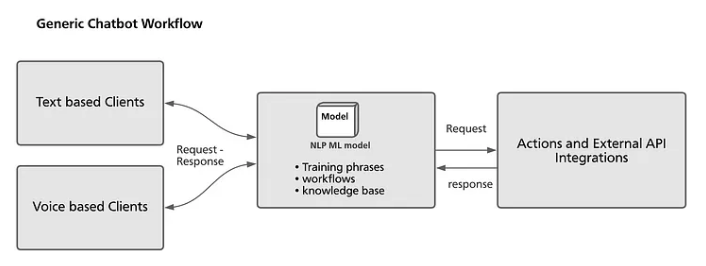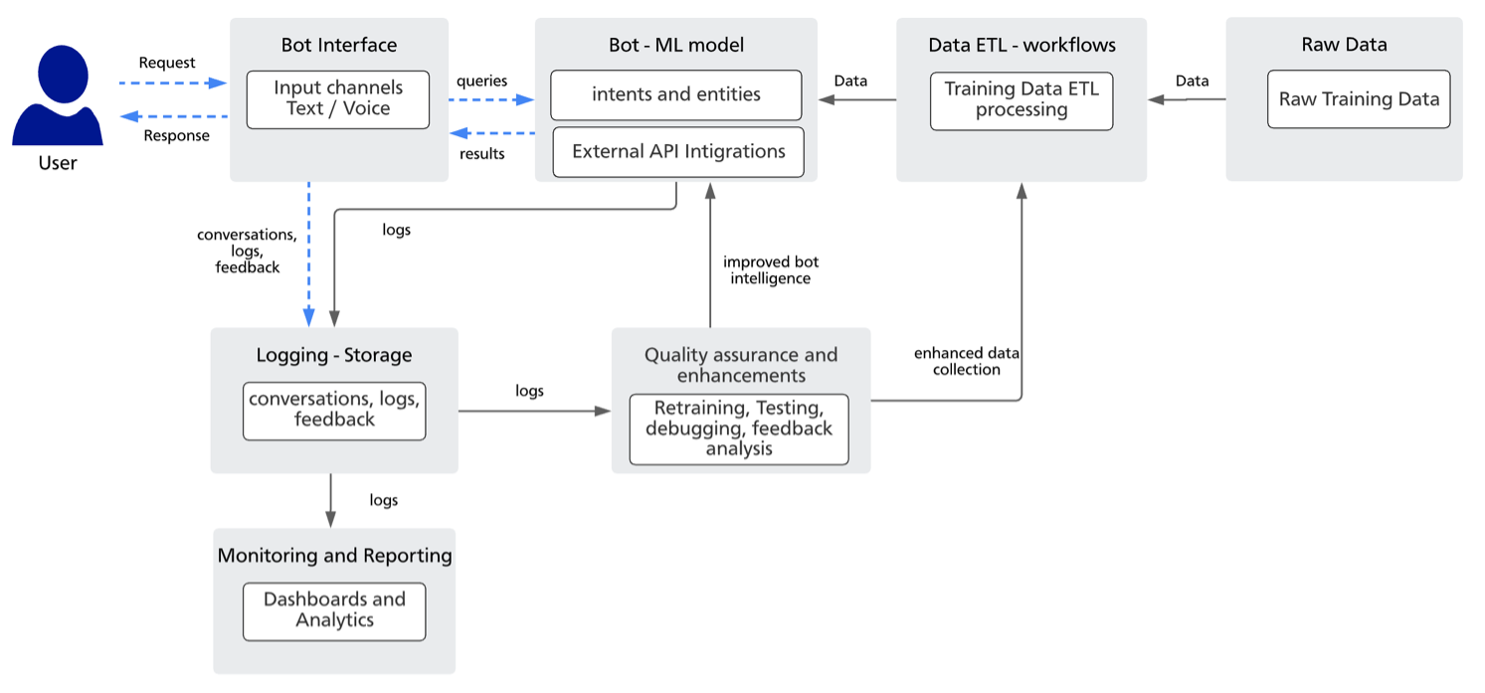Work faster work smarter with an automated chatbot
Fintech Organization | 250 Employees
This is a welcome development in a world where people want information right away and at their fingertips. Consequently, businesses are interacting with their customers more. It could be via humans interacting with customer service representatives, or automatically generating email drip campaigns.
Using natural language to interact with machines is one of the requirements of general artificial intelligence, or dialogue systems, spoken dialogue systems, or chatbots.
With AI Chatbots, enterprises can quickly create Virtual Agents that manage multiple topics, answer supplemental questions, and operate 24/7 across multiple channels to minimize live agent interactions.
Using natural language processing, contact center managers can identify call drivers and sentiments which can be used to improve customer interactions.
Companies have a greater chance of bringing in new customers if customers are satisfied. However, low CSAT(Customer Satisfaction) scores and customer dissatisfaction threaten your relationship with existing customers.
Several types of chatbots are available, some of which could be categorized as follows:
Text-based chatbot: In a text-based chatbot, a bot answers the user’s questions via text interface. Voice-based chatbot: In a voice or speech-based chatbot, a bot answers the user’s questions via a human voice interface.
By analyzing the characteristics of conversations a chatbot can hold, this research aims to identify metrics that can be automatically measured by evaluating the effectiveness of the bot. By automatically quantifying chatbot performance, new chatbot models can be prototyped and tested sooner and require fewer human evaluations.

Intelligence Enhances Customer Understanding
The combination of artificial intelligence and machine learning allows brands to gain an in-depth understanding of how customers behave and behave socially, historically, and through behavioral data.
Unlike traditional data analytics software, AI learns and improves continuously from data it analyses, anticipating customer behavior. As a result, brands can provide more relevant content, increase sales opportunities, and improve customer service.
With AI technologies incorporated into CRM platforms, sales teams are easier to understand and engage with customers through tools such as real-time decisioning, predictive analysis, and conversational assistants.
Conversational AI

Customer conversations can be more personalized using conversational AI. The customer now expects an omnichannel experience, and conversational AI can help accomplish that. Any customer can use the AI-based solution, regardless of what channel they use, whether it be a chat app, a live chat video, or social media, to personalize their experience, follow them across channels, and even see their history to deliver a seamless customer service experience.
Challenges of AI
Customers’ data is scattered across many different channels and disparate systems, which makes it difficult for brands to use AI. Prior to AI analysis, all data must be unified. Many brands are using a Customer Data Platform (CDP) to unify and analyze massive amounts of customer data. AI & ML Chatbot Solutions are a valuable source of customer delight for travel companies
Use cases in healthcare
One of the most valuable features of using chatbots in healthcare include:
- Anonymity: especially in sensitive and mental health issues.
- Monitoring: awareness and tracking of user’s behavior, anxiety, weight changes, to encourage developing better habits.
- Personalization: Level of personalization depends on the specific application. Some applications make use of measurements of
- Physical vitals (oxygenation, heart rhythm, body temperature) via mobile sensors
- Patient behavior via facial recognition
- Real time interaction: immediate response, and notifications and reminders.
- Scalability: ability to react with numerous users.
Examples of healthcare chatbots
Provide medical information
- Symptoms, diagnostics, markers, and available treatments are stored in massive healthcare data to train chatbot algorithms.
- Chatbots are continuously trained using public datasets, such as COVIDx for COVID-19 diagnosis and Wisconsin Breast Cancer Diagnosis (WBCD).
- Different levels of conversational chatbots can understand a user’s questions and provide answers based on predefined labels in the training data.
- An integrated chatbot extracts information about healthcare providers, open slots, and clinic and pharmacy working days from a medical facility’s system.
- A chatbot asks patients about their health issue, finds a physician or dentist that matches their condition, provides time slots, schedules, reschedules, and deletes appointments for patients.
- Users can also integrate chatbots with their devices’ calendars to receive appointments and reminders.
- Using simple questions about name, address, symptoms, current doctor, and insurance details, chatbots can extract patient information.
- In the medical facility system, chatbots store this information to facilitate patient admission, symptom tracking, doctor-patient communication, and medical record keeping.
- Healthcare resources and insurance services can be provided via chatbots for plan members and patients.
- Integrating RPA (Robotic Process Automation) and bots with insurance claims and medical billing can also automate the process.
- Patients’ names, birthdays, phone numbers, current doctors, last visits to the clinic, and prescription information is collected by chatbots.
- When a refill is available, the chatbot submits a request to the patient’s doctor.
- By automating prescription refills, doctors can process them in bulk or without doctor intervention.
Technical Design

This architecture describes the design and workflow of a conversational bot, the design is generalized in a way that to understand core components and their functionality in a cloud-agnostic design and common patterns, and workflows. This article also introduces some of the common technologies which can be used to build conversational chatbots.
Bot Interface:
This component connects bot communication channels, this can be apps, web services. It facilitates the communication between the bot and users.
Bot - ML model:
This component provides the Natural language understanding of deep learning models to extract entities and intentions to provide a response to user requests or other external actions. For example querying databases, running the business logic, and getting the answers to the user requests, etc.
Major cloud services providers have services that can provide this functionality, Amazon Lex, and Google Dialogflow, Azure LUIS. Most of them come with rich SDK and are developer-friendly.
Raw Data - Data ETL – workflows:
This is the raw data that the bot relay for Training phrases, These Training phrases are mapped to intents, entities are extracted based on which the actions are performed.
The Data should be processed and formatted in a specific way it can be fed to the NLU model.
There are a lot of options to process the data in cloud providers, we can use serverless compute options like Lambda functions or cloud functions, or build sophisticated batch data processing pipelines.
Logging – Storage:
It is important to understand how users are interacting with our bot so that we can continuously improve the bot based on past interactions. We can gain these actionable insights by monitoring and logging the bot conversations.
It helps us to identify matched intents and missed utterances. These missed phrases allow us to improve the bot design and improve the user engagement.
To protect sensitive data captured as entities, we can use the obfuscation feature to mask those values for logging. Both GCP and AWS provide these functionalities along with conversational model logs.
Monitoring and Reporting:
Monitoring and Dashboards help to identify metrics on intents and users and gives us insights on bot usage. And bot performance metrics. For example, what are the intents that are most used by users, and the number of missed intents that users are looking for, etc.
We use GCP and AWS services like Data Studio and QuickSight to create Dashboards and reports on conversational logs.
Quality assurance and enhancements:
The stored logs are used to improve the system and enhance the conversation workflow by retraining the system with new phrases or utterances
Quality assurance and enhancements:
- User message: User sends a message to the bot, it reads the message and sends it to a natural language understanding service. This step gets the intents and entities. The bot extracts data, that it sends to a service that serves information, The bot uses these results to construct a response.
- Response: Bot creates the response and sends it to the user. It is also logged to the logging system for further analysis.
- Logging: When a user request is received or response is sent, all conversation actions should be logged to a logging store, along with performance metrics and errors from external services. This data will be useful in monitoring, bug fixing, and improving the system.
- Feedback: We can also gather user feedback in terms of rating their satisfaction at the end of the conversation. Feedback can help us to improve the accuracy of responses
System Data flow:
The bot logic is constructed based on the information and knowledge extracted from the raw data by data processing systems. This data might be structured, semi-structured, or unstructured, data processing system extracts the data on batch mode and formats the data. The content is transformed and enriched, then used for the intent and Training phrases matching logic entity extraction.

Lakshmi is a team manager at Arocom. She is enthusiastic about learning and using the latest technologies of Artificial Intelligence (AI) and Machine Learning. Her main interest is in finding areas where AI and Machine Learning can be applied to solve problems

